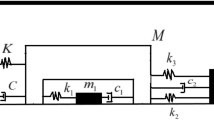Abstract
The behavior of shock vibration for a medium caliber gun barrel was experimentally investigated and then, numerical modal analysis, a signal processing technique as well shock response analysis were carried out en route to the detailed analyses. This approach was initiated by identifying mode frequencies from the numerical model and thus the frequencies were clarified using the periodogram together with the spectrogram based on the time frequency analysis. A shock response analysis was employed to draw more physical interpretations regarding the barrel behaviors due to firing shock. In this paper, therefore, the overall process of shock vibration analysis was demonstrated for analyzing the shock behavior of the gun barrel.
Similar content being viewed by others
References
I. A. McGregor, Telescoped ammunition: A future lightweight compact ammunition?, Canadian Army Journal, 12.2(11) (2009) 75–81.
M. T. Hale and R. Adhami, Time-frequency analysis of shock data with application to shock response spectrum waveform synthesis, IEEE, CH2998-3 0000-0213 (1991) 213–217.
D. W. Griffin and J. S. Lim, Signal estimation from modified short-time Fourier transform, IEEET Transaction on Acoustics, Speech, and Signal Processing, ASSP-32 (2) (1984) 236–243.
Z. K. Peng, P. W. Tse and F. L. Chu, A comparison study of improved Hilbert-Huang transform and wavelet transform: Application to fault diagnosis for rolling bearing, Mechanical Systems and Signal Processing, 19 (2005) 974–988.
S. Mallt, A wavelet tour of signal processing, Second ed. Academic Press (1999).
S. K. Lee, Y. W. Kim and M. H. Koo et al., Hilbert-Huang Transform (HHT) transient analysis of composite panel undergoing high-velocity impact, Journal of Mechanical Science and Technology, 24(12) (2010) 2395–2400.
ISO/WD 18431-4, Mechanical vibration and shock — signal processing — Part 4: shock response spectrum analysis, International Standard Copyright Office, Switzerland (2002).
A. Anderson and M. Ron et al., Department of defense test method standard for environmental engineering considerations and laboratory test, MIL-STD-810F, Method 516.5, Department of Defense, USA (2000).
C. M. Harris and A. G. Piersol, Harris’ shock and vibration handbook, 5th edition, McGraw-Hill, NY, USA (2002).
G. R. Henderson and A. G. Piersol, Evaluating vibration environments using the shock response spectrum, Sound and Vibration (2003) 18–20.
D. O. Smallwood, An improved recursive formulae for calculating shock response spectra, Shock and Vibration Bulletin, No. 56, Part 1 (1986) 279–287.
F. V. Hunt, Stress and strain limits on the attainable velocity in mechanical vibration, Journal of Acoustic Society of America, 32(9) (1960) 1123–1128.
E. E. Ungar, Maximum stresses in beams and plates vibrating at resonance, Trans ASME, J. Engrg. Ind., 32(1) (1962) 149–155.
H. A. Gaberson and R. H. Chalmers, Modal velocity as a criterion of shock severity, Shock and Vibration Bulletin, 40(part 2) (1969) 31–49.
Author information
Authors and Affiliations
Corresponding author
Additional information
Recommended by Editor Yeon June Kang.
Hakin In Gimm received his B.S. degree in the Department of Mechanical Engineering in Dankook University in 1982. He received the M.S. degree in the Department of Mechanical Engineering and Applied Mechanics at the University of Michigan and the Ph.D from the Department of Aerospace and Mechanical Engineering at the University of Arizona in 1989 and 1995, respectively. He is currently a principal researcher at the Agency for Defense Development, Korea. His research works include the shock analysis of structural and dynamic systems.
Ki Up Cha received his B.Sc. and M.S. degrees in the Department of Mechanical Engineering from Inha University, in 1984 and 1987, respectively. He is currently a principal researcher at the Agency for Defense Development. His current research interests include impulse and shock mitigation, application of multi-objective and particle swarm optimization.
Chang Ki Cho received his B.Sc. in Mechanical Engineering from Ajou University, Korea, in 1980, and his M.S. and Ph.D in Mechanical Engineering from Yonsei University, Korea, in 1991 and 1998, respectively. He is currently a principal researcher in the Agency for Defense Development. His research interests include multi-body modeling and vibration analysis for gun system, and impact dynamic analysis of structures.
Rights and permissions
About this article
Cite this article
Gimm, H.I., Cha, K.U. & Cho, C.K. Characterizations of gun barrel vibrations of during firing based on shock response analysis and short-time Fourier transform. J Mech Sci Technol 26, 1463–1470 (2012). https://doi.org/10.1007/s12206-012-0335-5
Received:
Revised:
Accepted:
Published:
Issue Date:
DOI: https://doi.org/10.1007/s12206-012-0335-5




